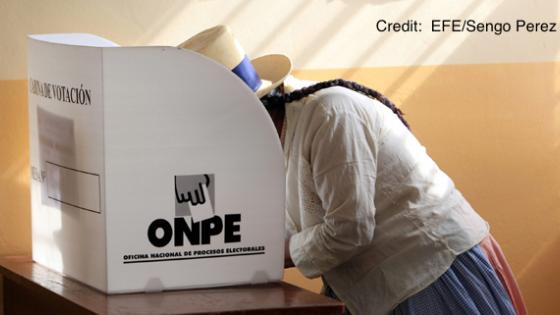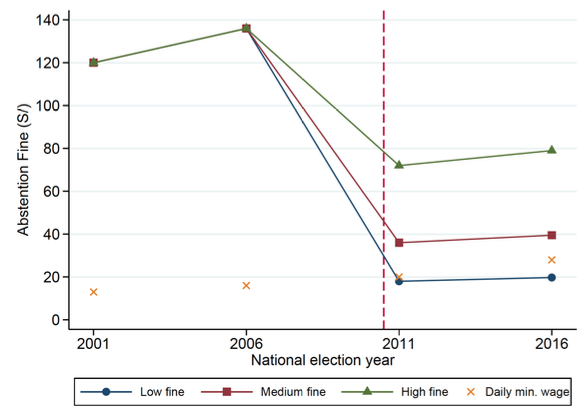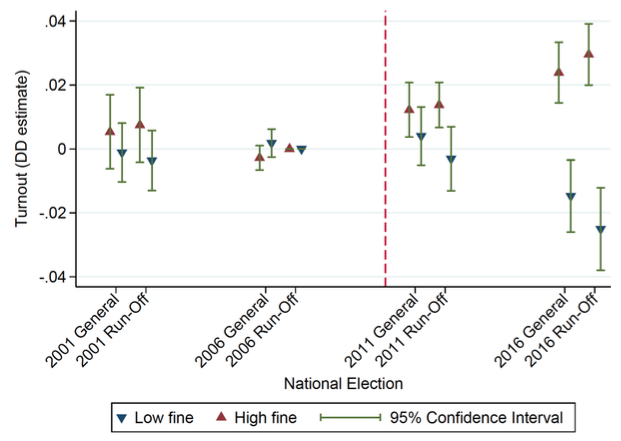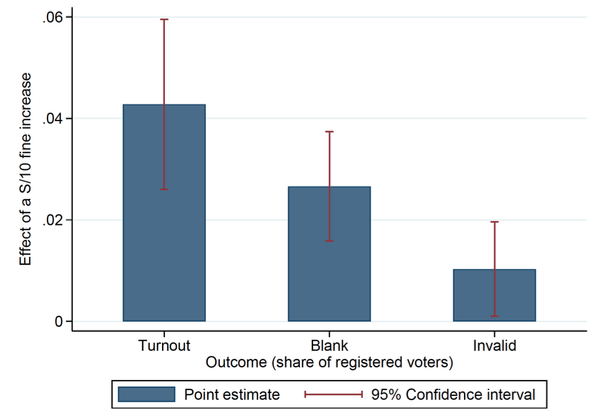Voting is the main tool at the disposal of citizens in democracies to ensure that government policies represent their interests, as well as to hold public officials to account (Ashworth 2012). Unfortunately, worldwide electoral participation has been dropping for the last 30 years (World Bank 2017).
What policy instruments – and empirical evidence on their effectiveness – do governments have at their disposal to draw a higher share of the electorate to the polls? While a large body of research has used field experiments to explore the effects of Get-Out-The-Vote campaigns (Gerber and Green 2017), the extent to which we can extrapolate these experimental findings to large-scale policies is uncertain (e.g. Al-Ubaydli et al. 2017, Banerjee et al. 2017.)
One plausible policy alternative, arguably consistent with the prominent role of elections in modern democracies (Chapman 2019), is the introduction of compulsory voting. In this regard, former US president Barack Obama has praised Australia’s compulsory voting regime (The Guardian 2016) and has claimed that introducing a mandate to vote in a country like the US would be “transformative” (Yan 2015). Currently, compulsory voting laws exist in almost 30 countries, but only ten enforce the mandate to vote and punish abstainers with a fine.1
Existing research shows that compulsory voting leads to higher turnout even with very low fines or enforcement (Funk 2007, Cepaluni and Hidalgo 2016, Hoffman et al. 2017). But voters’ responses to a change in the value of the fine remain uncertain. Would turnout be affected? If so, in what direction and by how much?2 Are there other potential behavioural responses? Would electoral results change? The answers to these questions have important policy implications, given the potential trade-off between the increased effectiveness of a larger fine and its greater burden on those who are sanctioned (plus the cost of enforcement).
In a new paper (Gonzales et al. 2019), we study a nationwide reform to the value of the abstention fine in Peru, a middle-income country with more than 20 million voters, where voting has been compulsory since 1933. Until 2006, the value of the abstention fine was homogeneous throughout the country. Following that year’s national elections, a newly introduced reform classified districts into three categories, based on their poverty level, and differentially reduced the value of the fine (Figure 1).3 Using administrative data covering four election cycles, we analyse voters’ short- and long-term responses along several margins, including turnout, registration, and invalid and blank votes.
Figure 1 Abstention fine by election and fine category
Figure 2 shows voter turnout rates in national elections in high- and low-fine districts, relative to medium-fine ones.4,5 Before the reform, the difference in turnout between all categories is quite stable. After the reform, we observe a systematic divergence in electoral participation between fine categories, leading to a five percentage point turnout gap between high- and low-fine districts by 2016, an important difference which could enlarge inequalities between districts.
Figure 2 Reform to the abstention fine and voter turnout
On average, we estimate that an increase in the fine of 10 Peruvian sol fine (roughly US$3) leads to a 0.5 percentage point increase in voter turnout. This estimate is substantially smaller than the one provided in León (2017) from a field experiment in the same setting, which involved an informational campaign about the modified value of the fine. This discrepancy is consistent with the large-scale policy having a reduced effectiveness relative to a salient experimental intervention. We conjecture that this ‘voltage drop’ is due to informational frictions, i.e. not all voters are informed about the change in regulation. Consistent with this interpretation, we provide causal evidence that voters seek more information about the abstention fines (from Google searches), and the effect increases substantially in later elections after the reform.
We also find that voters adapt to changes in regulation along unexpected margins. We examine how the abstention fine affects the number of registered voters in a district (Figure 3).6 There is a relative increase in the number of registered voters in low-fine districts after the reform (and a decrease in high-fine districts). In Peru, all individuals over the age of 18 are automatically registered to vote, but their voting district depends on the address in their national identification document. Hence, our results are consistent with voters intentionally manipulating their registered address in order to face a lower abstention fine.
Figure 3 Reform to abstention fine and voter registration
Further analyses reveal that the increase in registration is driven by first-time voters (ages 18–20), who must apply for a national identification document and hence face a negligible cost from strategically misreporting their address. These effects on registration, which are not typically captured in short-lived, localised field experiments, could lead to large biases in representation, especially for the young.
We further study the effects of monetary incentives on electoral results by focusing on the share of blank and invalid votes, which plausibly correspond to uninformed or uninterested voters.7 For the first round of the presidential election, a 10 sol increase to the value of the fine leads on average to a 0.37 percentage point increase in the number of blank (0.27 percentage points) or invalid votes (0.1 percentage points) as a share of registered voters (Figure 4).
This is equivalent to a staggering 86% of the observed effect of the fine on turnout for this type of election. This finding indicates that incentivising electoral participation may have a very small impact on election outcomes since most voters drawn to the polls by a larger fine end up casting a blank/invalid vote.
Figure 4 Reform to abstention fine and blank/invalid votes
Besides the monetary incentive provided by the fine, compulsory voting also provides non-monetary incentives, including the expressive function of the law as a signalling device for socially desirable behaviour (Funk 2007) and the temporary restrictions on government services faced by non-voters.
In order to gauge the relative importance of the monetary incentive, we benchmark our estimates against the aggregate effect of compulsory voting on turnout. For this purpose, we exploit the exemption from the mandate to vote for citizens above the age of 69. Using granular data at the voting-booth level from the 2016 elections, we compare turnout rates in booths with marginally older ‘barely-exempt’ voters (aged slightly above 69) to those with ‘almost-exempt’ 69 year-olds.8
The senior-citizen exemption from compulsory voting leads to a decrease in voter turnout of almost 10 percentage points at age 70 and 20 percentage points by age 72 (Figure 5). Using data from neighbouring Chile (which does not have compulsory voting) and running a similar analysis, we confirm that these effects are not driven by other factors, such as the worsening of health and mobility among the elderly. A back-of-the-envelope calculation using our previous results yields that a 100% fine reduction would lead to a decrease in turnout that is only 18% as large as the one caused by the exemption from compulsory voting between the ages of 69 and 72 (10% of the drop by age 75).
Figure 5 Senior exemption from compulsory voting and voter turnout
We conclude that monetary incentives have a robust, positive effect on electoral participation. But there are three important caveats that policymakers must keep in mind when contemplating the scale-up of experimental interventions in political economy.
First, the bundle of incentives provided by mandatory voting is substantially more effective than even large changes to the value of the fine. Hence, compulsory voting with low fines helps reduce the burden on those that pay them without fundamentally undermining the effectiveness of the system.
Second, in a setting where citizens do not face substantial barriers to electoral participation, the provision of powerful turnout incentives mainly affects disengaged citizens and has a negligible impact on electoral outcomes.
Finally, large-scale implementation of policies to increase electoral participation must carefully consider imperfect knowledge about the policy incentives, as well as potential unintended consequences. People respond in a multidimensional and sophisticated way to changes in the regulatory environment and it is difficult to capture this rich response in localised and short-lived field experiments.
References
Ashworth, S (2012), “Electoral Accountability: Recent Theoretical and Empirical Work”, Annual Review of Political Science 15(1): 183-201.
Banerjee, A, R Banerji, I Berry, E Duo, H Kannan, S Mukerji, M Shotland and M Walton (2017), “From proof of concept to scalable policies: Challenges and solutions, with an application”, Journal of Economic Perspectives 31(4): 73-102.
Cepaluni, G, and F D Hidalgo (2016), “Compulsory voting can increase political inequality: Evidence from Brazil”, Political Analysis 24(2):273-280.
Chapman, E B (2019), “The distinctive value of elections and the case for compulsory voting”, American Journal of Political Science 63(1):101-112.
Yan, H (2015), “Obama: Maybe it’s time for mandatory voting”, CNN.com, 19 March.
Funk, P (2007), “Is there an expressive function of law? An empirical analysis of voting laws with symbolic fines”, American Law and Economics Review 9(1): 135-159.
Bénabou, R, and J Tirole (2003), “Intrinsic and extrinsic motivation”, Review of Economic Studies 70(3): 489-520.
Bénabou, R, and J Tirole (2006), “Incentives and prosocial behavior”, American Economic Review 96(5): 1652-1678.
Gerber, A S, and D P Green (2017), “Field experiments on voter mobilization: An overview of a burgeoning literature”, in A V Banerjee and E Duflo (eds.), Handbook of Economic Field Experiments, Volume 1, North-Holland.
Gonzáles, M, G León and L Martínez (2019), “How effective are monetary incentives to vote? Evidence from a nationwide policy”, CEPR Discussion Paper 13898, Becker-Friedman Institute working paper 2019-101.
Hoffman, M, G León and M Lombardi (2017), “Compulsory voting, turnout, and government spending: Evidence from Austria”, Journal of Public Economics 145(1): 103–115,
International Institute for Democracy and Electoral Assistance (2018), “Compulsory voting”.
León, G (2017), “Turnout, political preferences and information: Experimental evidence from Peru”, Journal of Development Economics 127: 56-71
The Guardian (2016), “Barack Obama praises Australia’s mandatory voting rules”, 9 April.
World Bank (2017), World development report 2017: Governance and the law, Washington, DC: World Bank.
Endnotes
[1] Argentina, Australia, Belgium, Brazil, Ecuador, Luxembourg, Nauru, Peru, Singapore, and Uruguay (International Institute for Democracy and Electoral Assistance 2018).
[2] Stronger monetary incentives to vote could crowd out voters’ intrinsic motivation, potentially even reducing electoral participation (Bénabou and Tirole 2003, 2006).
[3] Districts classified as ‘extreme poor’ were assigned a low fine, those classified as ‘poor’ a medium fine, and those labelled as ‘non-poor’ were assigned a high fine.
[4] The legislative election and the first round of the presidential election take place simultaneously every four years. If no presidential candidate gets a majority of votes, a run-off election involving the two leading candidates takes place roughly two months later.
[5] These results come from a difference-in-difference model with district and time fixed effects.
[6] The voter registry remains constant for the presidential run-off.
[7] Unfortunately, Peruvian politics have been highly volatile in the past decades and no party systematically fielded candidates in the presidential elections during the sample period. Thus, we are thus unable to study party vote shares.
[8] We do these comparisons within the same district or even within the same polling station. We also flexibly control for the entire age structure of the registered voters in each booth.










